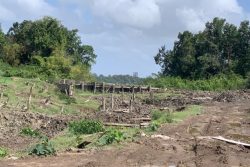– national plan to add value to agricultural produce on track
Local banana and plantain farmers can anticipate increased production this year following reported success by the National Agricultural Research Institute (NARI) in controlling the Black Sigatoka (dry leaf) infestation that significantly reduced production last year.
In a recent interview with NARI Director Dr Udho Homenauth, Stabroek Business learnt that the institute’s success in bringing the disease under control followed a six-month, $10 million investment in a number of surveys, engagements with farmers across the country and consultations with international microbiological scientists and plant pathologists.
Black Sigatoka is a fungal disease that creates progressively larger spots on plantain and banana leaves, resulting in a debilitating drying and discoloration of the leaves. The disease which is known to thrive in the humidity and wetness of tropical agricultural regions spreads from tree to tree through wind and rain irrigation can reduce plantain and banana yield by as much as 50 per cent.
Last year, extension workers attached to NARI’s Musa Disease Management Unit responded to reports of outbreaks of Black Sigatoka in several of the country’s farming regions. The resulting investigations revealed that plantain and banana farms in Region One had been completely infested with the disease while farms in Regions Three, Four, Five and 10 also showed signs of being affected. Simultaneously, NARI communicated the outbreak of the disease to the Food and Agricultural Organisation’s (FAO) office in Barbados following which a Plant Pathologist was dispatched to Guyana from the Caribbean Agricultural Research and Development Institute (CARDI). The visiting scientist’s investigation confirmed the suspected presence of Black Sigatoka and a recommendation was made that Guyana seek the services of the UK-based Caribbean Agricultural Bureau (CAB) to help fight the infestation. While awaiting a response from the CAB, NARI compiled a database of infested regions and the extent of infestation while continually monitoring the sector for further spread of the disease.
Homenauth told Stabroek Business that the principal effect of Black Sigatoka is on “the size” of the fruit. That apart, consumption of affected fruit poses no threat to human health.
Black Sigatoka has been known to manifest itself on plantain and banana plantations in other parts of the Caribbean and elsewhere and the common treatment applied in cases where the disease is mentioned is the frequent application of fungicides coupled with the removal of infected leaves, weeding, improved drainage and allowing for adequate space between plants. Armed with these recommendations from CARDI and the FAO NARI undertook an outreach programme for growers which saw the creation of growers’ clinics that provided advice and visual demonstrations on the treatment, control, monitoring and management of the plantations. Under the programme NARI provided the farmers with chemicals and other equipment and has undertaken to continually monitor the situation until Guyana is declared free of the disease.
Homenauth says Black Sigatoka is a difficult and expensive disease to control and that disease control measures account for a significant portion of production costs. He says, however, that NARI’s focus on combating Black Sigatoka is linked to its recognition of the importance of the local plantain industry to the Ministry of Agriculture’s planned 2011 focus on the use of plantains as one of several crops identified in pursuit of an aggressive drive to add value to locally produced crops in order to increase their export value. The ministry envisages a more aggressive regime of private production, packaging and marketing of the various by-products of plantains such as plantain flour, chips and strips, both to further minimise food imports as well as to seek to secure regional and extra-regional markets. Plantains apart, the value-added plan focuses on several locally grown crops including peppers, pumpkins and pineapples.
Homenauth says the Ministry of Agriculture’s value-added programme is “an evolving process” that is being supported by funding from the IDB and that much of the focus is on the “preservation and shipment” of products which, he adds, “requires a great deal of care and attention.” Currently, NARI is undertaking a special laboratory project aimed at bottling coconut water for export and another designed to accelerate the increased application of hydroponics to crop cultivation.
NARI is also paying attention to adding more value to cassava, which, the institute’s director says, is assuming increasing food value and may be set to significantly reduce the country’s food import bill. Cassava, he says, is relatively cheap, high in carbohydrates and produces significant volumes when pulverized. The immediate interest in cassava reposes in its potential role in local stock feed production where it is estimated that the crop could comprise as much as 5 per cent of poultry feed volume. Additionally, cassava adds additional carbohydrates to the feed while significantly reducing costs. Homenauth says that cassava could also replace the “blocks” made from molasses and urea that is used in livestock feed.
Other current research experimental pursuits, the outcomes of which could eventually become available to private farmers, include laboratory experiments in the growth of turmeric and black pepper which are among the spices imported into Guyana.





